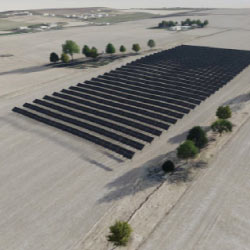
As the prevalence of solar increases in Wisconsin, there are more frequent questions about how agriculture and local communities are affected by solar arrays. Alliant Energy and the University of Wisconsin–Madison are partnering on a solar and agricultural research project to be established on university-owned land. In addition to generating clean electricity, the project will produce data and information to offer an example about how agriculture and renewable energy can coexist to create win-win opportunities for Wisconsin.
What is Agrivoltaics?
According to nonprofit organization RENEW Wisconsin, there are more than 20 large solar arrays currently operating in Wisconsin. While renewable energy advocates generally support such development, some solar arrays have caused controversy due in part to questions or concerns about renewable energy potentially displacing agricultural activities. It doesn’t have to be this way.
Agrivoltaics refers to combining agriculture and solar in the same location to create a win-win opportunity for agriculture and renewable energy. Solar arrays can be planned to accommodate agricultural or horticultural operations, such as allowing enough space between rows of solar panels to allow for harvesting crops or grasses. Solar arrays that combine agricultural activities have the potential to offer many benefits, such as promoting local agriculture, locally sourced energy, green jobs, and revenue for local communities. Key success factors to developing an agrivoltaics project include planning for stakeholder input, selecting sites with strong energy and agricultural potential, and designing a solar array to accommodate expected activities.
Planning a Solar Array for Agricultural Research

An agrivoltaics solar array is being designed on 15 acres within a larger 300-acre university research campus located in the Town of Dunn in Dane County, Wisconsin, through Alliant Energy’s Customer Hosted Renewables program.
Site selection factors for this project included:
- Environmental Impact Assessment (EIA) resulted in a finding of no significant impact (FONSI) to people, wildlife or the immediate environment.
- Located near existing transmission lines and existing university facilities
- Uses 15 acres of interior area with 280 acres continued usage as before for farming and recreational use
- Located on south-facing slope ideally suited for solar
- Avoided impacting more than five acres of prime agricultural soils
- Avoided wetlands and wetland setbacks
- Use of vegetative buffers to help shield views where requested
Designing the Solar Array for Multiple Uses
While designing the array, the Alliant Energy and UW–Madison project team incorporated input from university facility managers, researchers and students, local and county government, recreational users, neighbors, and the current agricultural tenant about the location, size, and configuration of the solar array. The solar array is being designed to accommodate multiple uses for research, demonstration, and education. Designs being considered include varied spacing between rows of solar panels and different racking heights and configurations of solar panels. At the end of the 25- to 40-year operational life of the solar array, the panels and racking are designed to be able to be removed so the land can be repurposed.
What Will Be Studied?
Over the last two years, UW–Madison has formed a community of practice with over 100 faculty, staff, and student researchers who contributed ideas and suggestions to this project. Two graduate capstone classes developed recommendations for research, demonstration, and education. Initial topics were prioritized based on from comments from public community discussions and from feedback received during local and county zoning review, these include:
- Solar array interactions with people, wildlife, plants, and pollinators
- Solar array effects on the natural environment including soil, water, and air
- Demonstrating economic and business development opportunities for families and businesses.
- Generating data and developing information to address questions from community, private sector, and public sector stakeholders
Research, demonstration, and education actions will continue to be developed over time with the goal of contributing to a greater shared understanding about agrivoltaics and its potential applications in Wisconsin.
What’s Next?
Construction on the 2.25 MW solar array is scheduled to start later this year. When energized next year, the solar array is expected to produce enough electricity to power 450 homes. The university recently awarded a $500,000 Research Forward grant to jumpstart research while faculty seek out additional funding to support project goals. More research at this solar array and at other locations is needed to better understand how we can continue to honor Wisconsin’s rich agricultural traditions while embracing our renewable energy future.
Get Involved
For more information about the planned agrivoltaics solar array, or to share suggestions about research, demonstration or education, please visit our website. You can also find more information about the Alliant Energy Customer Hosted Renewables program and RENEW Wisconsin’s solar and agricultural land use.
Josh Arnold, campus energy advisor at the UW–Madison Office of Sustainability, is the UW–Madison project manager for the solar and agricultural research pilot project. He is a board member of the nonprofit organization RENEW Wisconsin, which helped inform this article.